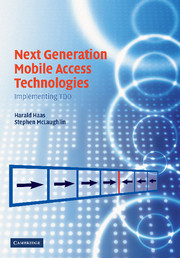Book contents
- Frontmatter
- Contents
- List of abbreviations
- Acknowledgements
- 1 Introduction
- 2 Wireless telecommunications using CDMA and TDD techniques
- 3 Interference and capacity analyses
- 4 Centralised DCA algorithm using the TS-opposing idea
- 5 Distributed DCA algorithm utilising the TS-opposing idea
- 6 UTRA-TDD Opportunity-Driven Multiple Access (ODMA)
- 7 Routing strategies in multi-hop CDMA networks
- 8 Multi-hop DCA
- 9 Radio resource metric estimation
- 10 Interference-based cancellation techniques for TDD
- 11 Smart Antennas for TDD-CDMA Systems
- 12 Cellular OFDMA-TDD
- 1 Derivation of T: Unconstrained Optimisation
- Bibliography
- Index
8 - Multi-hop DCA
Published online by Cambridge University Press: 02 September 2009
- Frontmatter
- Contents
- List of abbreviations
- Acknowledgements
- 1 Introduction
- 2 Wireless telecommunications using CDMA and TDD techniques
- 3 Interference and capacity analyses
- 4 Centralised DCA algorithm using the TS-opposing idea
- 5 Distributed DCA algorithm utilising the TS-opposing idea
- 6 UTRA-TDD Opportunity-Driven Multiple Access (ODMA)
- 7 Routing strategies in multi-hop CDMA networks
- 8 Multi-hop DCA
- 9 Radio resource metric estimation
- 10 Interference-based cancellation techniques for TDD
- 11 Smart Antennas for TDD-CDMA Systems
- 12 Cellular OFDMA-TDD
- 1 Derivation of T: Unconstrained Optimisation
- Bibliography
- Index
Summary
DCA techniques
Congestion-based routing, as developed in the previous chapter, is shown to require the lowest transmitted power, and in most cases achieves the highest capacity of all the routing algorithms examined in Chapter 5. All of these routing algorithms have allocated TDD time slots on a first-come-first-served basis and according to the rules outlined in section 6.4.1. This allocation only serves to ensure that the limitations of the TDD hardware are considered. It makes no attempt to optimise time slot allocation.
The allocation of time slots with regard to system performance has been shown to be an effective technique to mitigate interference (Haas, 2000). Integrating slot allocation, or DCA, into the routing algorithm would appear to be the most effective approach due to the interactive nature of interference. This approach will also need to conform to the extra limitations imposed by relaying. In addition to the rules in section 6.4.1, it is obvious that the slot allocation must be in the same order as the relays. A combined DCA will allow minimisation of the desired measure, in this case congestion, simultaneously in routing and slot allocation. This chapter develops a combined routing and resource allocation algorithm for TDD-CDMA relaying. It starts by reviewing one such algorithm applicable to TDMA and FDMA. A novel method of time slot allocation according to relaying requirements is then developed. Two measures of assessing congestion are presented based on matrix norms.
- Type
- Chapter
- Information
- Next Generation Mobile Access TechnologiesImplementing TDD, pp. 214 - 227Publisher: Cambridge University PressPrint publication year: 2008



